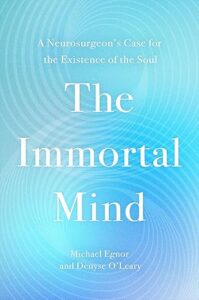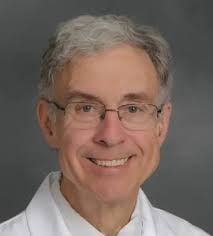The Immortal Mind, a new book by neurosurgeon Michael Egnor and science writer Denyse O’Leary, challenges some unexamined dogmas that dominate science classrooms and popular media — especially materialism, the theory that mind, spirit, and the soul are simply illusions and humans are mere meat machines. John Zmirak devoured the book and interviewed Egnor. Part I and Part II have already appeared.
John Zmirak: In your new book, you explore the growing field of Near Death Experiences and point to their nature as perhaps the strongest argument against materialism. How is studying these experiences undermining the faith of materialists?
Michael Egnor: Near-death experiences (NDEs) are a huge and complex topic. Tens of millions of people have had NDEs and similar spiritual experiences, and it’s been estimated that at least 1 in 20 Americans living today have had or will have an NDE — that’s more than 16 million Americans. About 20% of these NDEs involve out-of-body experiences, in which people during cardiac arrest see clearly what is going on around them, travel down a tunnel, see heaven, etc. Many of these experiences can be verified — people see things that can be checked and are true.
The most famous and remarkable example of a verified NDE was that of Pam Reynolds, who was a young woman with a large brain aneurysm who had brain surgery in 1991 to repair it. The surgeon needed to cool her body, stop her heart, and drain the blood from her brain in order to operate on the aneurysm. So she was clinically dead without brain activity during the operation and her death was verified by careful medical monitoring. Once the aneurysm was clipped, they rewarmed her body, restarted her heart and returned blood flow to her brain.
After the surgery, she reported that at the moment her heart stopped, she “popped” out of her body, floated up to the ceiling and watched the procedure. Then she went down a long tunned to a beautiful place where she saw dead family members who welcomed her — but told her she had to return to her body to raise her children. She told the surgical team about her experience, and she described in detail events that happened in the operating room while she was dead. She recounted exact conversations, actions of the surgeons and nurses, even the music that was playing the operating room while she was dead!
Not all NDEs are as dramatic or well-documented as Pam Reynolds’s, but there are hundreds of verified NDEs in the medical literature. When I discuss NDEs with materialists, I offer what I call the “Pam Reynolds Challenge”. There are four characteristics of verified NDEs exemplified by Pam Reynold’s experience that materialists must explain:
- Many NDEs are extremely clear and coherent, involving extraordinarily clear vision, life reviews, etc. This is unlike what happens when the human brain is dying, deprived of blood flow and oxygen, etc.
- Many NDEs have OOB experiences in which people see things in the resuscitation room while they are clinically dead that they could not have seen by physical means.
- To my knowledge, there has never been a report in the medical literature of a NDE experiencer who encountered living relatives or friends at the other end of the tunnel. NDE’ers only see dead people, even people who they didn’t previously know were dead.
- NDEs are life-changing, transformative experiences. Many people completely lose their fear of death.
I find the evidence convincing that there is survival of the soul after death. However, many questions remain. Does this mean that the soul is eternal, or just survives for a while? Why don’t NDEs correspond more closely to Christian or other religious views of life after death? Not all NDE’ers see Jesus, angels, etc. NDEs certainly point to survival of the soul after death, but the theological questions they raise are profound.
Materialists Refute Themselves
JZ: In the philosophical section of your book, you show how each of the theories offered by materialists to account for human rationality and subjectivity fail – becoming incoherent, self-refuting, or tautological. How would you sum that up briefly?
ME: There are several characteristics of rational thought that make it impossible for it to be generated by the brain. These include:
Precision: we can reason with precision—we can conceive of a perfectly straight line (the shortest distance between two points), the exact definition of a triangle (a closed plane figure with three straight sides and internal angels of exactly 180 degrees), a perfect circle (the set of points in a plane equidistant from a center point) etc., even though no material state of the brain can be perfect or exact (because of Heisenberg’s Uncertainty Principle).
Infinity: we can contemplate infinity, and even do mathematics using infinity, although our brain states are finite.
Logic vs. physics: relationships between ideas are logical, but relationships between brain states are physical, and there is no ontological overlap between logic and physics. How does reasoning and logic emerge from chemicals and protoplasm?
Simplicity: the soul is metaphysically simple, meaning that it can’t be split into independent parts. The brain can be split. Therefore, the brain does not explain the mind completely.
Self-refutation: materialist arguments that the mind is completely material are self-refuting. If we are machines made of meat, why would we pay attention to the opinions of “meat”. Physical things like brain states aren’t reasons or propositions, so why pay attention to them?
Materialists claim to be machines made of meat and they deny the reality of reasoning itself.
How Do Colleagues Treat You?
JZ: What has been the response of your colleagues to this book and its message? Is it breaking through, or are you hitting a wall of denial as people close ranks?
ME: My colleagues in neurosurgery and neuroscience have always been friendly and respectful of my opinions, but generally they are quiet and reserved on these issues. It’s noteworthy that other people I work with—students, nurses, friends, family etc. are often very supportive. It’s common that people I work with in the operating room and the clinics and even patients come up to me and tell me that they read our book and really liked it. They are grateful that we are speaking up about the truth about the soul.
Could This Book Change the Culture?
JZ: How did accepting the evidence for an independent, immortal soul change you? How could it change the culture?
ME: The evidence for the immateriality and immortality of the soul has strengthened my Christian faith. I’ve always tended to see the world through a scientific lens, and it is enormously gratifying to see that the truth is unitary. Faith and reason agree. This is not biased reasoning — as we point out in our book, although the immateriality and immortality of the human soul is a cornerstone of our faith, they are also conclusions drawn from the evidence from the best modern neuroscience. What my Christian faith teaches me is what my experience as a neurosurgeon and as a scientist teach me. For me, this is perhaps the most remarkable thing of all. The great theologians — St. Augustine, St. Thomas Aquinas, St. Bonaventure etc. — presaged 21st century neuroscience. That the human soul is spiritual is a truth of faith and a truth of science.
Science points to the immortality of the soul in two ways. First, NDEs of course affirm survival of the soul after death. Second, the immaterial and spiritual nature of the soul mean that the soul cannot die in the sense that our bodies die. Immaterial spiritual souls cannot disintegrate in a grave. We are naturally immortal. We are created by God to live forever.
The recognition of the immateriality and immortality of the human soul has profound implications for our culture. We have genuine free will, we have genuine reason, all human beings are immortal creatures with spiritual souls and are deserving of respect and love. Taking this truth to heart would transform our culture.
That said, I believe that atheism and materialism are on the wane. I believe that New Atheism and materialism were never viable metaphysical or scientific perspectives. They are vacuous nonsense. They were meant to open a door — to discredit the Christian understanding of nature and man—to let in paganism, which is an incredibly malignant force that is on the rise in the West.
Child sacrifice — abortion and the castration and sexual mutilation of mentally ill children, sexual grooming of children in schools, drag queen story hour for preschoolers, as well as “assisted suicide” and euthanasia for despondent people, rampant pornography and sexual perversion, and the ubiquitous moral relativism that plagues our culture … these are hallmarks of paganism. Paganism, unlike atheism or materialism, is a religious perspective that is appealing to billions of people, and in fact, is in a real sense the natural religion of man. It was paganism, not atheism and materialism, that Christianity vanquished, and it is paganism that is returning.
Christian faith and genuine scientific evidence and reason is helping to free our culture from atheist materialism, and we should keep in mind that the battle is not over. We face an historically malignant force — paganism — which will require new saints to join the battle which will continue until our Lord returns.
I am very concerned about paganism, which is clearly on the rise in our culture. I believe that materialism and atheism were never meant to be enduring philosophies — they have never been viable ways of understanding man and nature. They are intellectually and morally vacuous. Materialism and atheism were meant to discredit Christianity and open the door to paganism, which is enduring and poses an enormous threat to countless souls and to Western civilization.
Michael Egnor, M.D., is director of the Neurosurgery Residency Program at the State University of New York, Stonybrook. His practice includes patients diagnosed with Arnold Chiari deformity, hydrocephalus, cranio-synostosis, brain tumors, and spina bifida, as well as children with severe head trauma. He has an international reputation for research on hydrocephalus, and he is on the Scientific Advisory Board of the Hydrocephalus Association in the United States.
John Zmirak is a senior editor at The Stream and author or coauthor of 14 books, including The Politically Incorrect Guide to Immigration and The Politically Incorrect Guide to Catholicism. His newest book is No Second Amendment, No First.










